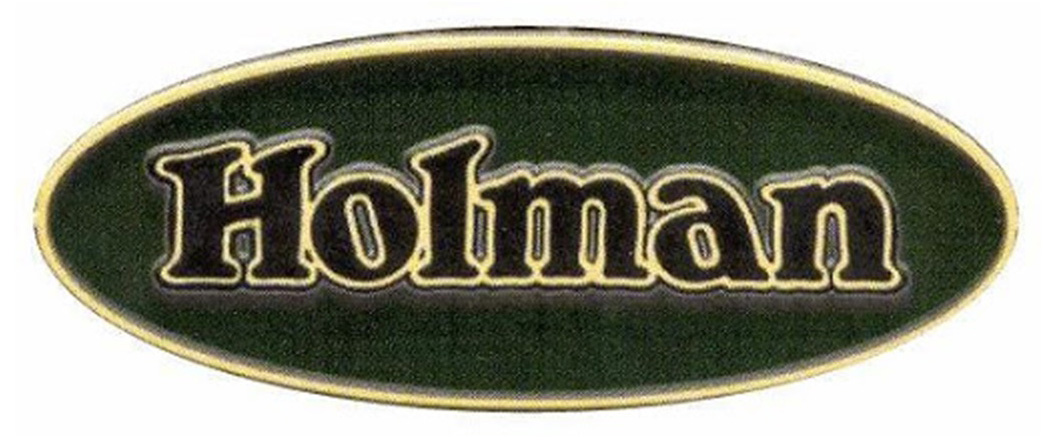
David Oates – a Camborne man, born and bred, reflects on an era now sadly come to an end and talks about the impact of a famous engineering firm on the Cornwall of the past two hundred years.
A gold watch beside me as I write, engraved with the distinctive “H” logo and the words, “for long and faithful service” is a poignant and tangible reminder of a now lost endeavour in my hometown. It belonged to my father who spent a lifetime working for the great engineering works of Holman Brothers of Camborne. I never worked for the firm but my life, and that of my family, was inextricably bound up with it for many, many years. I had imagined it might be my destiny also and my father arranged for me to go to the apprentice school to meet the head of the School, Freddie Oliver. I didn’t realise until later that it was a ruse as my father was a frustrated scholar who excelled at school but being one of eight children in Camborne during the 1930s, could not even think about further study – something he badly wanted for me as, although he became a fine engineer, intellectual study was his first love. I took an aptitude test and on leaving asked Fred Oliver how I had done – the response came – “I should stick to your schooling, my son”.
Not only my father worked there but his brothers, my uncles by marriage, my cousins, even my mother in wartime, and her father before her.
 Women workers in war-time – names on the left of photo – my mother is first left, front row
Women workers in war-time – names on the left of photo – my mother is first left, front row
My maternal grandfather, like the rest of them, was only a worker, with no great position, but for many years he was conductor of the works male voice choir and I have beside me, too, the personal letter from the managing director, on his death, expressing his regret at his passing and his thanks for the loyal service he had given the firm. That personal touch, from the man at the top, was so typical of the Camborne society of past generations and the ultimate demise of this significant feature of the Cornish scene was an almost emotional wrench, for like many in the Camborne-Redruth area, life without the dominating presence of this firm – even in later years when it diminished in size – was almost unthinkable.
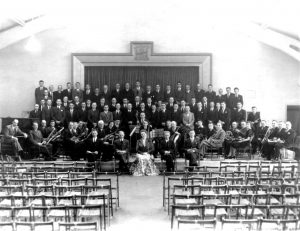 Holman Male Voice Choir with orchestra and guest artiste – c. 1950 – my grandfather, Bert Tredrea, is seated to the right of the guest artiste
Holman Male Voice Choir with orchestra and guest artiste – c. 1950 – my grandfather, Bert Tredrea, is seated to the right of the guest artiste

The Holman Male Choir some thirty years earlier – my grandfather, Bert Tredrea, seated in the middle of the first row, with dark curly hair and moustache. The bald, moustached man standing behind him and to his right, is Richard Henry Davies, of Troon, the only survivor of eight men entombed in Dolcoath Mine by a massive fall of ground, in September 1893. He lay, with his dead comrades, for several days until a rescue party reached him.
For almost two hundred years, Camborne had been a company town – but not in the B-movie sense where the inhabitants’ every move was controlled and governed by the company. There was a benevolence, a sense of paternalism about it that sits uneasily in the twenty-first century but for those who experienced it, there was an enviable sense of safety and security, for the firm felt a real responsibility for the community. Its buildings dominated the town with the accompanying noise and smells. Much of the site was where Tesco is now but has forever lost the appeal of those iconic buildings.
 The frontage of the factory in Wesley Street, now the home of Tesco
The frontage of the factory in Wesley Street, now the home of Tesco
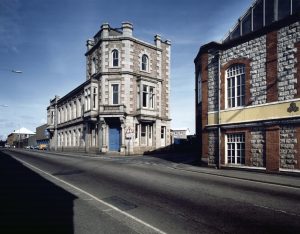 One of the “head offices” – they became larger and grander as the firm grew – now Tesco car park
One of the “head offices” – they became larger and grander as the firm grew – now Tesco car park
The Holman family founded its foundry in the fledgling town of Camborne almost two centuries ago, in response to the needs of the growing mining industry, and town and company grew together. Many of the great steam engines whose evocative houses still litter the Cornish landscape, were built and repaired here, the company acting with such speed and efficiency on one occasion, when there was a breakdown at the great Wheal Grenville Mine, in nearby Troon, that the huge beam of one of the massive pumping engines, weighing many tons, had to be recast at the foundry, and was returned to the site so quickly that it still retained its heat and men had to wrap sacking around their hands to deal with it. At one stage my grandfather was a fetler (1) in the moulding shop where he would clean up and tidy the castings. In later life he became a clerk in the offices.
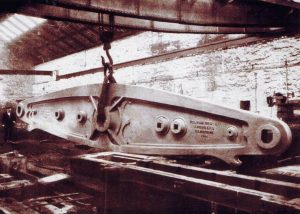 New beam made in the foundry for Gould’s Engine, Wheal Grenville Mine
New beam made in the foundry for Gould’s Engine, Wheal Grenville Mine
As mining declined locally, however, the firm diversified and established branches in every major British city and a network of outposts across the world wherever there was a demand for mining machinery. Compressed air machinery was its forté and it was always at the cutting edge of development. To this day, the massive compressors, with the distinctive “H” logo, can still be found all round the world.
 Holman compressors apparently photographed at Lynmouth, possibly after the 1953 floods
Holman compressors apparently photographed at Lynmouth, possibly after the 1953 floods
That skill with compressed air even extended to the development of weapons powered by it in wartime, when the factory made a massive contribution to the production of armaments. Camborne men were found in every continent, serving the needs of not just mining, but the civil engineering industry as well. To this day, some of those managers and engineers still work in places like West Africa, where the skills provided by Holman Brothers have enabled them to prosper and develop business endeavours of their own. Back home in Cornwall, the whole economy of a large part of the west of the county rested on this firm. It employed over 3,000 men in its heyday and took in up to 100 apprentices every year to go through its world-renowned Training School.
 Apprentice school – my uncle, Ronnie Oates, explaining something to a student
Apprentice school – my uncle, Ronnie Oates, explaining something to a student
The factory stretched from one end of the town to the other, had its own designated rail link that ran from the main line to the farthest part of the works a mile or more from the main line, and even had its own test mine in the granite above Troon. The family’s base was in an elegant Georgian house, set in rolling parkland, and with its own Home Farm – that still graceful house is now apartments for the well to do.
At its most successful, and sadly not too long before its ultimate demise, a new and extensive head office was built off Dolcoath Avenue – the building now occupied by Cornwall Council.
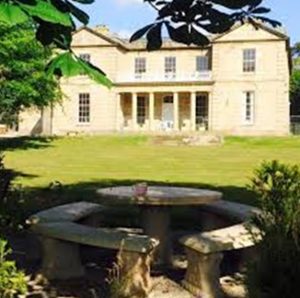 Rosewarne House – another head office
Rosewarne House – another head office
Such was its influence that the firm even owned its own hotels in the town – large houses where representatives and visitors from the market they served could be accommodated comfortably when they came to Camborne to do business. Such was the extent of their property that some apprentices were trained, not in engineering skills, but in the building and maintenance skills needed to keep this extended estate, including the great houses of the family members scattered across the county, in good repair.
For most people, though, there were markers, each day, that reminded them of the dominance of the firm in the town. At the required times, men were summoned to work by blasts of the great hooter at the factory, heard for miles around, and at mid-day, and at the end of the afternoon, the main street of Camborne, Trelowarren Street, was one mass of humanity as men, on foot and bicycle, filled it from end to end. Such was the influence of “’Olman’s ooter” that even farmers in the countryside around the town used it to go in for dinner – always dinner in Camborne and then tea – we didn’t know what lunch was!
In Wesley Street, where Tesco now stands, was the moulding shop, the distinctive and acrid smell which grew stronger the nearer you got. Then there was the now disappeared railway crossing at Roskear, taking the train out to the boiler works, and where the school bus was often held up, to our great delight. Everyone in the town, too, knew one special employee, Jan Luke, for it was he who took responsibility for every little job done that was not essentially part of the production process, for every piece of timber that found its way into local sheds and pigeon-lofts, and for every brush-full of that distinctive green paint, destined for the machinery produced, but seen on private properties through the district! On one noteworthy occasion a worker who was a renowned breeder and shower of bantams had a prize breeding cock with a broken leg and the resources of one part of the foundry were called on to design and produce the most efficient splint for this bird’s leg. Such was the skill involved that the bird recovered and resumed his duties!
The firm knew that it depended on the community to provide its work force and acted to ensure their loyalty and support. That loyalty was much eroded in recent years but when the Holman family held the reins, they were at the centre of both the economic and social life of the town.
A job for life!
Leonard Hart, who was museum curator and then safety officer for the whole UK operation, had fond memories of the responsibility taken by the management for the work force. Going to work for Holman’s, he said, was literally a job for life. Although he was merely a worker, the birth of his first child was marked with flowers from the wife of the managing director and that this was not unusual. All the workers referred to the bosses in a quaint way – they were “Mr Treve” or “Mr Kenneth” – the surname being unnecessary. He remembers the 150th anniversary of the firm in 1951, when every employee was given an extra week’s wages, a dinner and entertainment by celebrities from London, followed by the directors pulling pints of beer for the workers! Every year, too, the firm organised “Holman’s Week” when there were celebrity concerts, dare-devil acts in the park, interworks sports competitions and a grand fire-works display – a real boost for workers whose holidays were spent largely in the locality. One regular contributor was Jack Warner of “Dixon of Dock Green” fame, brought from up country for the delight of the workforce. There were extravagant Christmas parties for the workers’ children with food, presents for all, film shows and entertainment, and there was a quarterly magazine with reports of the many clubs and societies subscribed to by the workers in their free time. Nor was this confined to Camborne for this, and another publication, “Holman Notes” reported on, and supported, workers of all colours and creeds right across the world. Photos from the depths of the South African Gold Mines, or from the plains of India, were well known to Camborne folk. This desire to involve the work-force went much further and, every fortnight, on a rota basis, groups of workers who had only experienced one aspect of the production process, were given an afternoon off work, were told to put on their glad rags and were taken on a tour of the work’s complex to see the whole picture, from start to finish. After the tour, they took afternoon tea with the directors!
This intimacy, this involvement with community was the cement that held it together – an alien concept to the faceless corporations of today but one from which they could learn so much.
Camborne today is still recovering from the demise of Holman Brothers but, whatever the future brings, that sense of community and pride will never return in the same measure.
End notes:
- Fetler: Someone whose job is to sand and grind small imperfections from metal castings.
Cover photo: The Holman name plate

David Oates is a Cornish bard who has published a history of Troon, entitled “Echoes of an Age”, a guide to Godrevy and Gwithian, “Walk the hidden ways” and a slim volume of his own verse, “Poems from the far west”. His unpublished work includes a reflection on a Cornish childhood, “What time do they close the gates, Mister?” and a fictionalised story for young people based on the extant life of St Gwinear, with the working title, “The son of a king”. David is working on another guide in the “Walk the hidden ways” series, entitled “Hard Rock country”.
David is a tenor singer with the well-known group, Proper Job based in mid- Cornwall and has collaborated with Portreath musician, Alice Allsworth, to write the lyrics for a number of songs about Cornwall and the Cornish.

What memories this invokes. As a child I lived in The Glebe and attended the C of E school in College Street. Later on I attended Redruth Grammar and moved to Tolcarne Street. In 1963 I had an interview with Fred Oliver and became a Student Apprentice so I was sent to the “Tech” in Pool where I eventually qualified with a HND in Mechanical Engineering.
I have very fond memories of my apprenticeship which was split between time at college and time in the works. So many wonderful and some very colourful charcters such as Fred- very imposing figure sat behind a large desk, Joe Trounce the apprentice school foreman and others – too many to mension.
The outpouring of people at the 12:00 o’clock hooter and the steady stream back to work by 1:00pm, the clocking in and out both morning and afternoon and the many Jan Lukes that were produced are all remembered with fondness and a tinge of sadness that it has all gone now.
Thanks for re-kindling the meories.
I had a Great Grandfather Holman, who emigrated from Cornwall late 19th century, along with his new Cornish r wife., they lived tempor,arily in Liverpool, where they took part in a censor, where there name was recorded as Homan.
They then moved to Rhyll in North Wales and procduced many chlldren including my Grandfather. and built a number of local businesses including the inport of Coffee beans ……..I visited a museum in Cornwall where it was said the Holman`s association with Cornwall goes back a thousand years!
Can anyone give me my true relationship to the Holmans??
My maiden name is Holman. I have 3 generations traced in the Redruth/Camborne area going back to 1817. Unlikely connection as they appeared to be mostly miners and farmers but would be interesting to check out names with you?
My dad, Frank Cudlip was the works engineer at Holmans and had a lot of input into the centralisation scheme and building of the admin block during the mid 1960’s. He was a Holmans man through and through and loved working there. Later he was promoted to works manager and then director at Maxam Power. When I left school I started a technician apprenticeship with Holmans and learnt many skills that still stand me in good stead. The beauty of the apprenticeship was that one spent time in so many different manufacturing facilities, from the heavy machine shop to the foundry and drop stamp. There were so many unique characters around as well, I have to say that I really enjoyed my whole apprenticeship.
My Dad Jack Warmington,worked at Holmans from the age of fifteen till he retired at sixty . he started as a moulder and ended up in charge of personnel .I well remember growing up in a small prosperous Camborne and not how different it is on my infrequent returns to Cornwall. David mentions Home Farm and our back garden in North Parade backed on to the scout hq and over the hedge was that farm . I used to play there with Gerald Treloar the son of the farmer.
Hello I am the sister of Gerald Treloar. Pamela I remember you your sister Patricia, your mum and dad. I also worked at Holman Bros for nine years from school. Good memories of Camborne back then but not in modern times. Regards Pam Menear.
Hello Pamela nice to read your reply..I agree with you about the Camborne of then …how is your brother Gerald ?
Now 84 yrs I recall an apprenticeship with Holman climax mfg I calcutta india with fond memories of Joe Blight, Ken pengelly , Edward (ted) leakey, Syd Taylor & Roy Sen (sales)..
I left Bird & Co ,managing agents, in 1964 to migrate to UK. I wish to be able to know if any survivors or relative are known. Robert Young
My paternal grandmother was Mary Elizabeth Holman born in Atherton Lancashire in 1897. Her father was Francis Holman who originated in Cornwall and was involved in tin mining I believe.
She married my grandfather John Davies Speakman in 1919.
Hi my name is Donna Stahl (ne. Holman). My father was Trevor Philip Holman who was born and raised in South Australia. His family dates back to 1757 to a James Holman from Crowan. He married a Rachel Medlyn who had a son named John. Holmans were based in Crowan until 1839, when a John & Millicent Holman migrated to Australia (settling in Willunga, South Australia). This is the side of the family where my father, Philip Trevor Holman, comes from.